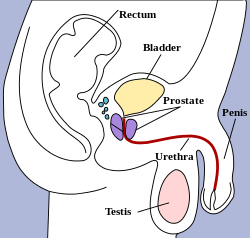Genitourinary system
The genitourinary system, or urogenital system, are the organs of the reproductive system and the urinary system.[1] These are grouped together because of their proximity to each other, their common embryological origin and the use of common pathways, like the male urethra. Also, because of their proximity, the systems are sometimes imaged together.[2]
| Genitourinary system | |
|---|---|
 Some components of the male genitourinary system | |
| Details | |
| Identifiers | |
| Latin | Apparatus urogenitalis, systema urogenitale |
| MeSH | D014566 |
| Anatomical terminology | |
The term "apparatus urogenitalis" was used in Nomina Anatomica (under Splanchnologia) but is not used in the current Terminologia Anatomica.
Development
The urinary and reproductive organs are developed from the intermediate mesoderm. The permanent organs of the adult are preceded by a set of structures that are purely embryonic and that, with the exception of the ducts, disappear almost entirely before the end of fetal life. These embryonic structures are on either side: the pronephros, the mesonephros and the metanephros of the kidney, and the Wolffian and Müllerian ducts of the sex organ. The pronephros disappears very early; the structural elements of the mesonephros mostly degenerate, but the gonad is developed in their place, with which the Wolffian duct remains as the duct in males, and the Müllerian as that of the female. Some of the tubules of the mesonephros form part of the permanent kidney.
Disorders

Disorders of the genitourinary system includes a range of disorders from those that are asymptomatic to those that manifest an array of signs and symptoms. Causes for these disorders include congenital anomalies, infectious diseases, trauma, or conditions that secondarily involve the urinary structure.
To gain access to the body, pathogens can penetrate mucous membranes lining the genitourinary tract.
Urogenital malformations include:
As a medical specialty, genitourinary pathology is the subspecialty of surgical pathology which deals with the diagnosis and characterization of neoplastic and non-neoplastic diseases of the urinary tract, male genital tract and testes. However, medical disorders of the kidneys are generally within the expertise of renal pathologists. Genitourinary pathologists generally work closely with urologic surgeons.
See also
References
- "genitourinary system" at Dorland's Medical Dictionary
- "UC Davis Department of Radiology - Genitourinary Radiology". Retrieved 2010-03-16.
-solution.jpg)

